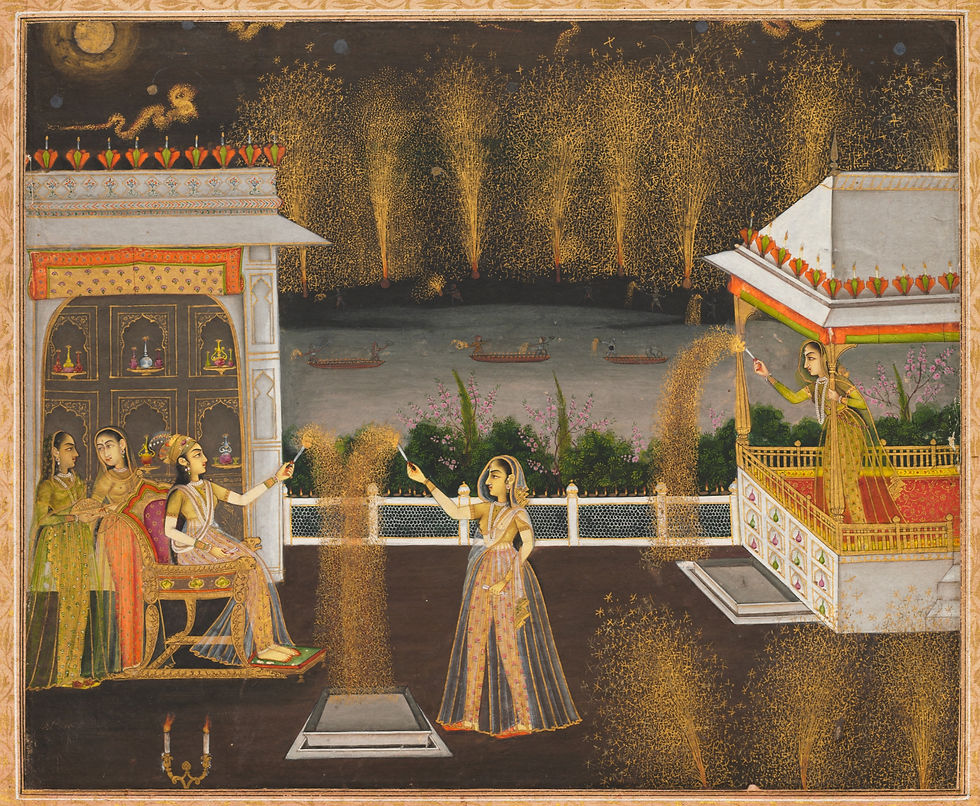Bagh-e-Hind: The Soundtrack
- Uzair Siddiqui

- Sep 5, 2021
- 3 min read
Updated: Dec 1, 2022

Curator's Note:
In building a multi-sensory exhibition online, I had to consider what elements might deepen the viewer's experience of the seventeenth and eighteenth century Mughal era. The paintings my co-curator Nicolas Roth selected and wove together with Urdu poetry from the period, enriched our narrative around this remarkably alluring world. However, I was still wondering about ways in which we could unlock an emotionally saturated "vision" of a garden bursting with fragrant blooms. Could we make the many aspects of this exhibition, i.e. the paintings, the plants, the objects, the perfumes and flavours, sing?
The classical music curated as part of Bagh-e Hind, is the ethereal thread that weaves through our exhibition, intangibly tying all its various elements in place. Around July 2021, I had invited Berkeley-based architect Uzair Siddiqui to explore some flavour translations that he could produce for audiences in the United States, but our conversation took a turn into his exploration on Classical Hindustani music and the specific emotions they are associated with. We connected our ideas on experiencing scent and music by the season or time of day. For instance, Mitti or “wet soil” is a perfume I produce only during the summer and monsoon seasons. This mirrors his practice of creating playlists of ragas that describe the joys of the monsoons. Around the time I had this conversation with Uzair, I was also familiarising myself with scholar Dipti Khera’s recently published monumental book "The Place of Many Moods" that dives into the brilliance with which 18th century Udaipur court painters composed evocative monsoon imagery! I also found “Histories Of The Ephemeral”, a podcast by scholar Katherine Schofield on the socio-political power of music in Mughal India to be insightful.
While all these aspects of early modern South Asian history are entirely new to me, on an instinct, I commissioned Uzair to compile a playlist for our Bagh. He made such a stunning shortlist by early September 2021 that I decided we did not need to match just one sound to one painting, we could include it all to create a maximal impact of the mood encoded in each illustration. This soundtrack itself has expanded my understanding of these genre-paintings across our five chapters. Take for instance painting 5 that depicts the Ragini figure seated on a bed of flowers awaiting her lover within a lush bower. When Nicolas selected this image for me to translate to scent, I did not connect with it at all, nor did I find his explanation of the painting - beyond the identification of all the trees and flowers - satisfying somehow. Further, I resisted its central note, the musky kewra plant, to such a point that I asked him to choose another image, which went against our general terms of agreement. However, it was Uzair’s selection of “Raag Nayaki Kanada” that clicked into place for me the weight of her range of expectations and emotions so richly textured in this painting in our "Kewra" chapter.
The following are Uzair's selections and the notes he left for my reference:
Chapter 1: Rose

Raag Adana
Ustaad Bade Ghulam Ali Khan, Patiala Gharana
Shubha Mudgal
Perhaps the painting demands a man’s sound (not to say a less obviously devotional composition but they’re both about valour so Ram features prominently in both) but I really really LOVE Shubha Mudgal’s version. Especially when she descends into drut (faster movements towards the end of a piece).
Chapter 2: Narcissus

I am leaning more towards the Pilu or Puriya Kalyan
Raag Pilu or Mishra Pilu (romantic, lofty but with intellectual depth)
Thumri in Mishra Pilu
Pandit Venkatesh Kumar, Kirana and Gwalior Gharana
“Gayo re Madho, piya bides gayo”
Raag Chandranandan (moonstruck, beauty)
Ustaad Ali Akbar Khan, Maihar Gharana
Puriya Kalyan (menacing, passionate)
Pandit Buddhaditya Mukerjee, Imdadkhani Gharana
Chapter 3: Smoke

Kathak sequence from Jalsaghar (Satyajit Ray, 1959) featuring Roshni Kumari
Chapter 4: Iris

Raag Shuddh Sarang
Nityanand Haldipur, Maihar Gharana
Vilambit (slow rendition):
Drut (fast):
Chapter 5: Kewra

Raag Nayaki Kanada
Ashwini Bhide Deshpande, Jaipur-Atrauli Gharana
Vilambit- Mero Piya Rasiya
Drut- Ratiyaan Main Jaagi
Raag Patdeep
Indrani Mukherjee, Kirana-Rampur Gharana
“Sajan pat phoole birma, jaa re kaaga un ko le aa”
Raag Sorat - Pt. Ajoy Chakraborty
Follow Uzair's multi-disciplinary practice via @siddici on Instagram




Comments